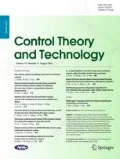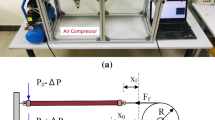Abstract
This paper develops a discrete-time sliding mode controller with a power rate exponential reaching law approach to enhance the performance of a pneumatic artificial muscle system in both reaching time and chattering reduction. The proposed method dynamically adapts to the variation of the switching function, which is based on an exponential term and a power rate term of the sliding surface. Thus, the controlled system can achieve high tracking performance while still obtain chattering-free control. Moreover, the effectiveness of the proposed method is validated through multiple experimental tests, focused on a dual pneumatic artificial muscle system. Finally, experimental results show the effectiveness of the proposed approach in this paper.








Similar content being viewed by others
Abbreviations
- PAM:
-
Pneumatic artificial muscle
- PID:
-
Proportional integral derivative
- SISO:
-
Single input single output
- DSMC:
-
Discrete-time sliding mode control
- ERL:
-
Exponential reaching law
- PRERL:
-
Power rate exponential reaching law
- RMSE:
-
Root mean square error
References
Chavoshian, M., & Taghizadeh, M. (2020). Recurrent neuro-fuzzy model of pneumatic artificial muscle position. Journal of Mechanical Science and Technology, 34, 499–508.
Feja, K., Kaczmarski, M., & Riabcew, P. (2006). Manipulators driven by pneumatic muscles. In M. O. Tokhi, G. S. Virk, & M. A. Hossain (Eds.), Climbing and Walking Robots (pp. 775–782). Springer.
Zhao, L., Liu, X., & Wang, T. (2019). Trajectory tracking control for double-joint manipulator systems driven by pneumatic artificial muscles based on a nonlinear extended state observer. Mechanical Systems and Signal Processing, 122, 307–320. https://doi.org/10.1016/j.ymssp.2018.12.016
Kalita, B., & Dwivedy, S. K. (2019). Dynamic analysis of pneumatic artificial muscle (PAM) actuator for rehabilitation with principal parametric resonance condition. Nonlinear Dynamics, 97(4), 2271–2289.
Zhang, C., Hu, J., Ai, Q., Meng, W., & Liu, Q. (2017). Impedance control of a pneumatic muscles-driven ankle rehabilitation robot. In Y. Huang, H. Wu, H. Liu, & Z. Yin (Eds.), Intelligent Robotics and Applications (pp. 301–312). Springer.
Banala, S. K., Kim, S. H., Agrawal, S. K., & Scholz, J. P. (2009). Robot assisted gait training with active leg exoskeleton (ALEX). IEEE Transactions on Neural Systems and Rehabilitation Engineering, 17(1), 2–8. https://doi.org/10.1109/TNSRE.2008.2008280
Dao, Q.-T., & Yamamoto, S.-I. (2018). Assist-as-needed control of a robotic orthosis actuated by pneumatic artificial muscle for gait rehabilitation. Applied Sciences, 8(4), 499. https://doi.org/10.3390/app8040499
Hussain, S., Xie, S. Q., & Jamwal, P. K. (2013). Control of a robotic orthosis for gait rehabilitation. Robotics and Autonomous Systems, 61(9), 911–919. https://doi.org/10.1016/j.robot.2013.01.007
Andrikopoulos, G., Nikolakopoulos, G., & Manesis, S. (2014). Advanced nonlinear PID-based antagonistic control for pneumatic muscle actuators. IEEE Transactions on Industrial Electronics, 61(12), 6926–6937. https://doi.org/10.1109/TIE.2014.2316255
Anh, H. P. H., & Ahn, K. K. (2011). Hybrid control of a pneumatic artificial muscle (PAM) robot arm using an inverse Narx fuzzy model. Engineering Applications of Artificial Intelligence, 24(4), 697–716. https://doi.org/10.1016/j.engappai.2010.11.007
Xie, S., Liu, H., & Wang, Y. (2020). A method for the length-pressure hysteresis modeling of pneumatic artificial muscles. Science China Technological Sciences, 63(5), 1869–1900.
Xie, S., Mei, J., Liu, H., & Wang, Y. (2018). Hysteresis modeling and trajectory tracking control of the pneumatic muscle actuator using modified Prandtl–Ishlinskii model. Mechanism and Machine Theory, 120, 213–224. https://doi.org/10.1016/j.mechmachtheory.2017.07.016
Vo-Minh, T., Tjahjowidodo, T., Ramon, H., & Van Brussel, H. (2011). A new approach to modeling hysteresis in a pneumatic artificial muscle using the Maxwell-slip model. IEEE/ASME Transactions on Mechatronics, 16(1), 177–186. https://doi.org/10.1109/TMECH.2009.2038373
Lilly, J. H., & Quesada, P. M. (2004). A two-input sliding-mode controller for a planar arm actuated by four pneumatic muscle groups. IEEE Transactions on Neural Systems and Rehabilitation Engineering, 12(3), 349–359. https://doi.org/10.1109/TNSRE.2004.831490
Xing, K. (2010). Tracking control of pneumatic artificial muscle actuators based on sliding mode and non-linear disturbance observer. IET Control Theory and Applications, 4(10), 2058–2070.
Chiang, C.-J., & Chen, Y.-C. (2017). Neural network fuzzy sliding mode control of pneumatic muscle actuators. Engineering Applications of Artificial Intelligence, 65, 68–86. https://doi.org/10.1016/j.engappai.2017.06.021
Ahn, K., & Cong Thanh, T. D. (2004). Improvement of the control performance of pneumatic artificial muscle manipulators using an intelligent switching control method. KSME International Journal, 18(8), 1388–1400.
Vo, C. P., To, X. D., & Ahn, K. K. (2019). A novel adaptive gain integral terminal sliding mode control scheme of a pneumatic artificial muscle system with time-delay estimation. IEEE Access, 7, 141133–141143. https://doi.org/10.1109/ACCESS.2019.2944197
Mohorcic, J., & Dong, L. (2021). Extended state observer-based pressure control for pneumatic actuator servo systems. Control Theory and Technology, 19(1), 64–79.
Dao, Q.-T., Nguyen, M.-L., & Yamamoto, S.-I. (2019). Discrete-time fractional order integral sliding mode control of an antagonistic actuator driven by pneumatic artificial muscles. Applied Sciences, 9(12), 2503. https://doi.org/10.3390/app9122503
Dao, Q.-T., Mai, D.-H., Nguyen, D.-K., & Ly, N.-T. (2022). Adaptive parameter integral sliding mode control of pneumatic artificial muscles in antagonistic configuration. Journal of Control, Automation and Electrical Systems, 33(4), 1116–1124.
Dao, Q.-T., & Le Tri, T.-K. (2022). Discrete-time sliding mode control based on exponential reaching law of a pneumatic artificial muscle actuator. Journal of Mechanical Engineering, 19(1), 221–237.
Ma, Z., & Huang, P. (2021). Nonlinear analysis of discrete-time sliding mode prediction deployment of tethered space robot. IEEE Transactions on Industrial Electronics, 68(6), 5166–5175. https://doi.org/10.1109/TIE.2020.2992006
Ma, Z., & Huang, P. (2020). Discrete-time sliding mode control for deployment of tethered space robot with only length and angle measurement. IEEE Transactions on Aerospace and Electronic Systems, 56(1), 585–596. https://doi.org/10.1109/TAES.2019.2917490
Fellag, R., Hamerlain, M., Laghrouche, S., & Achour, N. (2017). Adaptive discrete sliding mode control of a pneumatic artificial muscles robot. In 2017 5th International Conference on Electrical Engineering—Boumerdes (ICEE-B) (pp. 1–6). Boumerdes, Algeria. https://doi.org/10.1109/ICEE-B.2017.8192099
Fallaha, C. J., Saad, M., Kanaan, H. Y., & Al-Haddad, K. (2011). Sliding-mode robot control with exponential reaching law. IEEE Transactions on Industrial Electronics, 58(2), 600–610. https://doi.org/10.1109/TIE.2010.2045995
Gao, W., & Hung, J. C. (1993). Variable structure control of nonlinear systems: a new approach. IEEE Transactions on Industrial Electronics, 40(1), 45–55. https://doi.org/10.1109/41.184820
Abidi, K., Xu, J.-X., & She, J.-H. (2009). A discrete-time terminal sliding-mode control approach applied to a motion control problem. IEEE Transactions on Industrial Electronics, 56(9), 3619–3627. https://doi.org/10.1109/TIE.2008.2010203
Abidi, K., Xu, J.-X., & Xinghuo, Y. (2007). On the discrete-time integral sliding-mode control. IEEE Transactions on Automatic Control, 52(4), 709–715. https://doi.org/10.1109/TAC.2007.894537
Li, S., Du, H., & Yu, X. (2014). Discrete-time terminal sliding mode control systems based on Euler’s discretization. IEEE Transactions on Automatic Control, 59(2), 546–552. https://doi.org/10.1109/TAC.2013.2273267
Devika, K., & B., & Thomas, S. (2017). Power rate exponential reaching law for enhanced performance of sliding mode control. International Journal of Control, Automation and Systems, 15(6), 2636–2645.
Author information
Authors and Affiliations
Corresponding authors
Additional information
Quy-Thinh Dao, Trung-Kien Le Tri, Van-Anh Nguyen and Manh-Linh Nguyen have contributed equally to this work.
Rights and permissions
Springer Nature or its licensor holds exclusive rights to this article under a publishing agreement with the author(s) or other rightsholder(s); author self-archiving of the accepted manuscript version of this article is solely governed by the terms of such publishing agreement and applicable law.
About this article
Cite this article
Dao, QT., Le Tri, TK., Nguyen, VA. et al. Discrete-time sliding mode control with power rate exponential reaching law of a pneumatic artificial muscle system. Control Theory Technol. 20, 514–524 (2022). https://doi.org/10.1007/s11768-022-00117-8
Received:
Revised:
Accepted:
Published:
Issue Date:
DOI: https://doi.org/10.1007/s11768-022-00117-8




